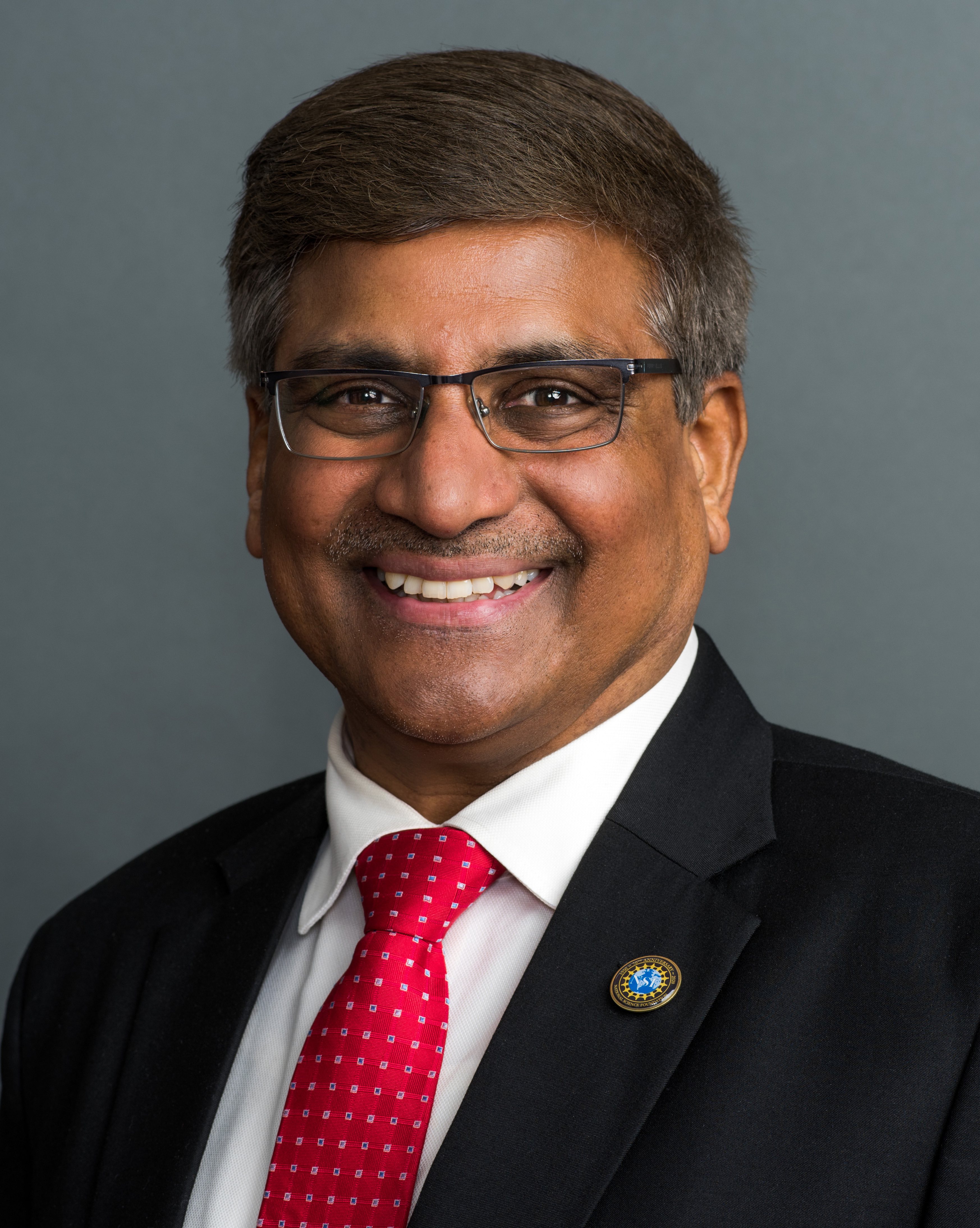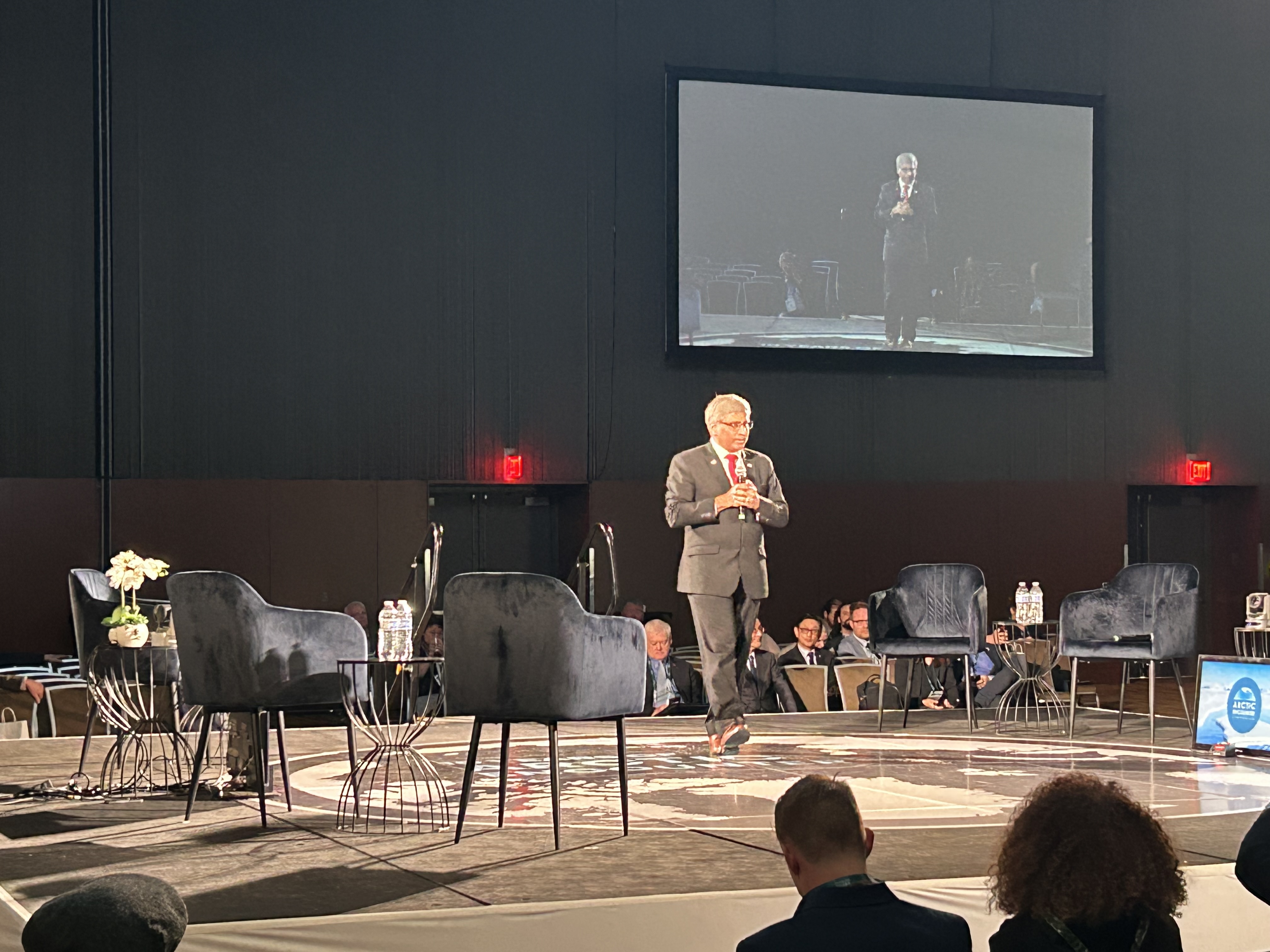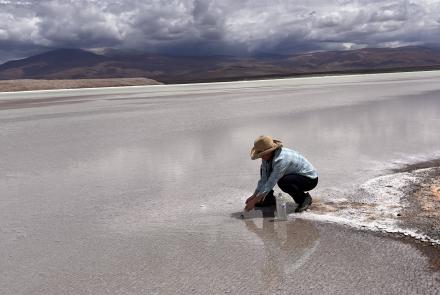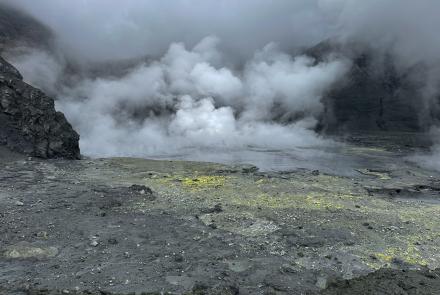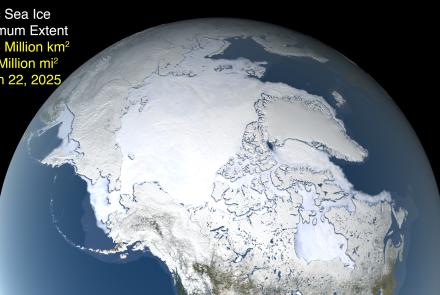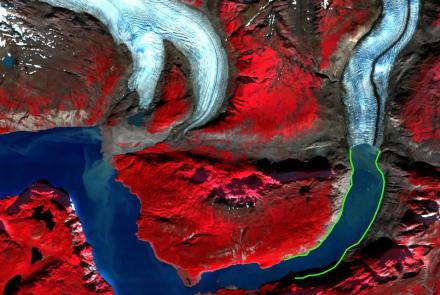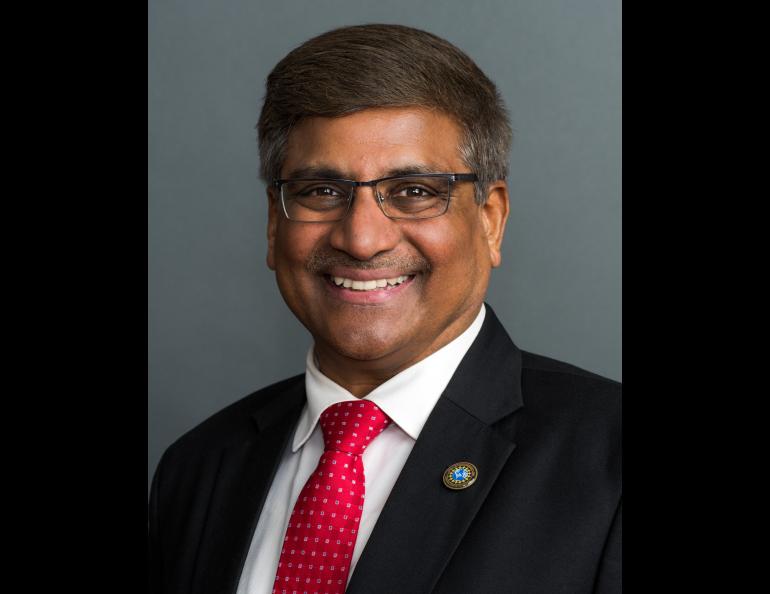
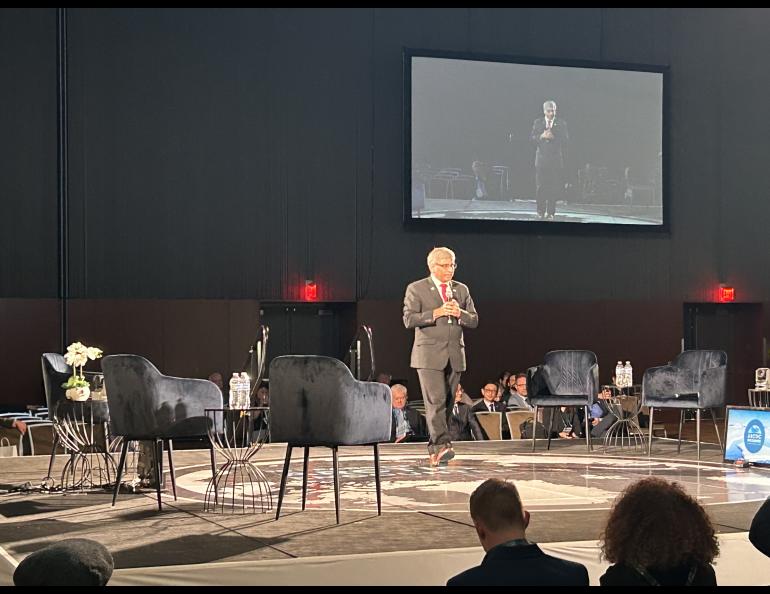
NSF director: 'I am grateful to UAF’s partnership'
Dr. Sethuraman Panchanathan became the 15th director of the National Science Foundation in June 2020 when the U.S. Senate confirmed his presidential appointment to the position.
Panchanathan visited the University of Alaska Fairbanks in April while in Alaska to attend the annual Arctic Encounter Symposium in Anchorage. Arctic Encounter brings together policymakers, diplomats, national security officials, Indigenous leaders, and many others with Arctic interests for three days of discussions about challenges in the far north.
At Arctic Encounter, Panchanathan made featured remarks and then participated in a panel discussion titled “The Future of Scientific Research and Innovation in the Arctic.”
Prior to his visit to Alaska, the UAF Geophysical Institute Communications Office asked Panchanathan several questions about the NSF, about Arctic research and about UAF. His written responses are below.
•••
QUESTION: The February 2022 NSF Quarterly stated this in the “News from the Director” column: “We are working with our multi-sector partners to ensure that anyone — from any background or part of the country — who has the talent or desire to go into a STEM career is given the opportunity to do so. To that end, NSF is investing in people and programs that strengthen pathways into STEM fields, prepare a diverse workforce, and foster communities of inclusivity and mentorship.”
You said in that column that, “I strongly believe the future depends on bringing out domestic talent in full force.”
Can you elaborate on NSF’s efforts to achieve that? And how does NSF-funded research at the University of Alaska Fairbanks and other universities help with that effort?
Panchanathan: Incredible scientific breakthroughs cannot and do not happen on their own. They are powered by a community of talented researchers, engineers and entrepreneurs across the nation who have been given the opportunities they need to succeed in STEM. But not everyone has been given the same opportunity.
There is a gap between the demographics of the research community and the demographics of a whole nation. Because of this gap, insights and creative new ways of thinking are being lost. NSF is committed to reducing that gap, so everyone has access to the resources, education and opportunities to succeed. We consider universities like University of Alaska Fairbanks partners in this endeavor. Together, we can harness the full potential of the STEM talent across the nation.
One way we are doing this is through the EPSCoR program. NSF recently announced a $20 million investment in the state of Alaska through EPSCoR, a program that aims to build and bolster infrastructure to advance scientific progress and elevate discovery nationwide. The Alaska NSF EPSCoR RII Track-1 project, called “Interface of Change (IoC),” will build collaborative research capacity to assess the impact of climate-induced changes on marine resources important to high-latitude coastal communities.
•••
QUESTION: A March 15, 2024, NSF news item about an event at the White House related to the 2024 “Science and Engineering Indicators” report says you “spoke of the need to reverse several concerning trends identified in this report, accelerate American science and engineering innovation and unleash the potential of the ‘missing millions’ by investing in STEM education, industry and infrastructure for everyone across the nation.”
What can the University of Alaska system and state government leaders do to help?
Panchanathan: The future of U.S. leadership in STEM depends on our ability to invest in the industries of today while laying the foundation for the industries of tomorrow. It also requires us to train the next generation workforce and unleash the amazing potential that exists across all demographic and geographic backgrounds. This cannot be accomplished in a vacuum. Partnerships across the research enterprise are vital to achieving this goal.
Tapping into the missing millions takes collaboration across state, federal and local governments; tribal communities; universities like the University of Alaska; and industry. Working together, we can create opportunities so that everyone, everywhere across the nation, can participate to the full extent in the STEM enterprise.
•••
QUESTION: New NSF proposal requirements coming out soon include a new requirement that researchers obtain approval of tribal communities before receiving NSF funding to proceed with the research.
What is the significance of that requirement?
Panchanathan: NSF’s updated PAPPG requirement seeks to address the "nothing about us without us" concern raised by many Tribal Nations. The new PAPPG requirement requires proposers who seek NSF funding for their research to seek prior approval from Tribal Nations if their proposed research has the potential to impact the interests or resources of Tribal Nations. The request for approval must be submitted with the proposal, but NSF funding cannot be awarded unless the approval (or a document from the Tribal Nation saying approval is not needed) is submitted by the proposer.
•••
QUESTION: What do you see as the most pressing needs in Arctic research? This could be topics of research, commitment of nations to Arctic research, more scientists doing Arctic research, etc.
Panchanathan: The Arctic is a critical and complicated region with several, often interconnected, pressing needs. Collaboration in science and technology is critical to addressing the multitude of challenges we are facing. NSF is making real investments to foster a collaborative ecosystem that includes scientists, engineers and scholars from a multitude of disciplines to enable a comprehensive approach to Arctic research — one that combines cutting-edge science with traditional knowledge to create a holistic understanding of the region. This includes our dedication to involving Indigenous communities in the Arctic research process. The wisdom and experience of these communities are invaluable, offering perspectives that have been honed over centuries.
•••
QUESTION: The recent Science and Engineering Indicators report says “China is the top producer of S&E doctoral degrees.”
What is your reaction to that? What can U.S. universities do about that?
Panchanathan: The current fiscal environment coupled with the intense global competition for leadership in STEM presents serious challenges for the nation. There will be real impacts across the research enterprise with the reduction of NSF’s budget. It is difficult to place this in the context of rapid, large-scale science investments by competitors such as China, with the express purpose of outcompeting the United States.
NSF is working closely with the White House and Congress to optimize existing resources to ensure critical investments are made in science, innovation and the STEM workforce that benefit the American people every day. We remain committed to unleashing talent, ideas and innovation everywhere across our nation and remain optimistic that future budgets will support this critical mission and move closer to the bold vision set out under the CHIPS and Science Act of 2022.
•••
QUESTION: The Science and Engineering Indicators report says, “The U.S. R&D system — and by extension, the nation’s competitiveness — relies heavily on foreign-born scientists and engineers, especially at the doctorate level.”
What is your reaction to that?
Panchanathan: We must continue to invest in nurturing and strengthening domestic STEM talent. At the same time, we must continue to be a beacon for international talent and leverage STEM talent from around the world.
•••
QUESTION: NSF’s November 2023 “Missing Millions” report states that, “…as of 2021, American Indian or Alaska Native, Black or African American, and Hispanic students were underrepresented among science and engineering certificate and degree award recipients at most award levels relative to their proportions of the U.S. population that was 20-34 years old.”
How is NSF helping to improve that? Is there progress?
Panchanathan: NSF is committed to reaching the “missing millions.” Doing so is central to the nation’s long-term economic and national competitiveness. In order to compete with countries like China, the U.S. must engage everyone who wants to participate in STEM, inspire them to do so and give them the opportunity to be successful.
In order to achieve the scaling of research and innovation happening across the broad geography of the country, we are providing support the research community needs — especially emerging research and minority-serving institutions — to be successful.
Through NSF’s Growing Research Access for Nationally Transformative Equity and Diversity (GRANTED) program, we are encouraging nationally transformative ideas and scalable models to strengthen the nation’s research enterprise by supporting access to the human capital, practices and processes that support researchers, investigators and students engaged in basic and use-inspired research and training in STEM.
GRANTED focuses on addressing systemic barriers within the nation’s research enterprise by improving research support and service capacity.
GRANTED is a whole-of-NSF approach that will transform NSF and the science and engineering community to develop the collective knowledge, skills, talents and desire to serve within the nation’s science and engineering enterprise.
•••
QUESTION: Is the U.S. well-positioned in developing an S&E workforce for the years ahead?
Panchanathan: Ensuring our nation remains ahead of its competitors in science and engineering requires us to tap into the vast pools of talent that exist in regions and communities currently underrepresented in STEM. NSF investments in education and training programs attract individuals from diverse backgrounds and from every sector. These investments — spanning pre-K through graduate school and beyond — ensure a pipeline of people and ideas ready to solve pressing global challenges in science and engineering.
•••
QUESTION: Tell us about the relationship between NSF and the University of Alaska Fairbanks. What are the benefits of having a research university in the far north of the United States?
Panchanathan: University of Alaska Fairbanks’ location, commitment to its diverse peoples and dedication to research make it an invaluable partner to NSF and the STEM enterprise. We have entrusted UAF with operating key research infrastructure like R/V Sikuliaq and Toolik Field Station, and we invest millions of dollars annually in projects across many areas of research at UAF. I am grateful to UAF’s partnership and look forward to continuing to work together to promote the progress of science across the nation.
• Rod Boyce, University of Alaska Fairbanks Geophysical Institute, 907-474-7185, rcboyce@alaska.edu

